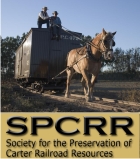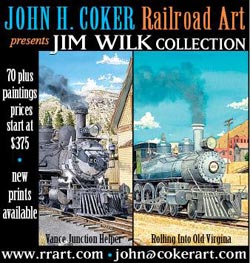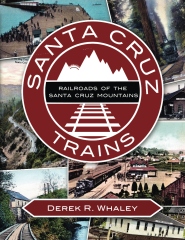

Reference Data.
30" GaugeMainline Length.
1.2 mi
Rail Weight.
16 lb rail
Maximum Grade.
Grade, up to 180’ per mile (3.4%)
The Eureka Mill Railroad.
By Cliff JenningsT he Eureka Mill, located along the line of the Virginia and Truckee Railroad in the Brunswick (Carson River) Canyon, started life as part of a series of consolidations and improvements conducted by the Union Mill and Mining Company. The Eureka Mill property was acquired 1871. The UM&M Co. was one of many businesses owned by the Bank of California “crowd” who’s members were found on the Board of Directors of many of the mines, the Bank of California and Virginia & Truckee Railroad among other notable Comstock establishments. They regularly acquired properties by the over extension of credit and foreclosure method.
In the Autumn of 1871 construction was underway on a state-of-the-art 60 stamp mill. To power the mill, a larger 200' stone dam was constructed on the river, replacing the earlier 125' dam connected to the mill by 3/4 mile long, 26’ high by 200’ wide wooden flume. In 1872 the company began construction of a 30” gauge tramway by laying rails atop the flume. An additional half mile of grade was constructed along the Carson river as far as Santiago Canyon where the ore bin connected to a 350’ (30 degree slope) ore slide from Eureka switch on the V&T.
To move the ore, four 5-ton iron bodied ore cars were ordered from the V&T shops. These cars were smaller versions of those used by the V&T. The line was worked by gravity from the ore bin to the mill, when a single car with brakeman would make use of gravity. On the return trip a horses or mule pulled trains of two empty cars and the brakemen back up to the ore bin for their next load.
At the mill, two cars at a time were pulled by cable up an incline trestle where they were dumped into the grizzly above the stamp batteries. Empties were then set on a siding for the return trip back to the ore bin.
By summer of 1887 a more efficient means of moving ore was needed and the railroad was upgraded with the purchase of a 5 1/2 ton 0-4-0T locomotive named “Eureka”, built by H.K. Porter. The “Eureka” was initially used on the existing rails atop the flume. After initial trials (and planned upgrades to the flume) this arrangement was found unsuitable. The railroad was relocated to a new roadbed that paralleled the flume from Mill to the Dam, supported much of the way by a masonry retaining wall. In Santiago canyon, two trestles were constructed, one 1000 ft long trestle called the “High Trestle”. Around the mill the yard was enlarged and a small engine house built for the locomotive.
After the arrival of the “Eureka” the original ore slide was replaced by a 400’ counter-balanced incline railway. The original arrangement had been found maintenance intensive due to the damage caused by the falling ore which left the lower bin in need of constant repair. The new system increased capacity allowing for two cars to be loaded from the ore bin. Six additional ore cars and two flat cars were purchased from the V&T shops to meet increased demands.
The ore milling operation had been kept in good repair and improvement until tragedy struck on May 04, 1892 when an early morning fire completely destroyed the Stamp mill and heavily damaged the flume nearby. The cause of the fire was attributed to repairs performed the previous day. The railroad remained largely unharmed, except for a stretch of track atop the flume. The UM&MCo. rebuilt the mill on the original foundations to process tailings from the area. This operation closed in 1893, as a result of falling silver prices. The mill was sold to new owners and reopened in 1894.
In 1897 the property was sold to Alexander J. McCone 1 who rebuilt the mill into a cyanide process facility to reprocess Comstock tailings. The Eureka Mill became one of two mills of this type in the area. Track around at the mill was rearranged to enter the building directly and the former cable incline arrangement was removed. At the same time an additional bin was added at V&T ore transfer increasing capacity and an 18” gauge tramway was added to connect to an ore bin served by wagons. The next year, in 1898, the mill was again increased in size.
The mill continued operation until 1901 when it finally shut down. The property was sold to Captain Herman Davis of Dayton who also owned the Rock Point Mill and Nevada Reduction works and the 3’ gauge Dayton, Sutro, & Carson Valley Railroad. He apparently planned to move the mill equipment to his other properties, but the mill reportedly sat idle until finally scrapped in 1906. The remaining flume and trestles were destroyed on March 20, 1907 when the Carson River flooded the site.
Some time after operations ceased, the “Eureka” was sold to a contractor (likely the Utah Construction Company) and subsequently moved to their projects at Lake Almanor and Butt Valley Reservoir for Pacific Gas & Electric. The other locomotives used on this project were 3’ gauge, and it is not known if the locomotive was operated or just used for spare parts. In 1996 Butt Valley Reservoir was drained so the dam could be repaired and strengthened and the forgotten “Eureka” was discovered. “Eureka” was removed from the lake and cleaned up and put on display at a park alongside Highway 36 in Chester California.
Bibliography
Farrell, Mallory Hope, Fine Scale Railroader, The Eureka Mill Railroad, part 1, August/September 1997
Farrell, Mallory Hope, Fine Scale Railroader The Eureka Mill Railroad Conclusion, October/November 1997
Farrell, Mallory Hope, Narrow Gauge Short Line Gazette, Eureka Mill Railroad – Prototype and Models, Volume 13, No. 5, November/December 1987
Farrell, Mallory Hope, Narrow Gauge Short Line Gazette, Along the Thirty-Inch Gauge Railroads, The Eureka Mill Railroad (part 1) Volume 31, No. 5, November/December 2005
Farrell, Mallory Hope, Narrow Gauge Short Line Gazette, Along the Thirty-Inch Gauge Railroads, More on the Eureka Mill Railroad (part 2) Volume 31, No. 6, January/February 2006
Farrell, Mallory Hope, Virginia & Truckee, The Bonanza Road, Mulilteo, WA, Hundman Publishing, 1999
Myrick, David, Railroads of Nevada and Eastern California, Vol. 1, Berkeley, Howell North, 1963
Wurm, Ted and Demoro, Harre, The Silver Short Line, A History of the Virginia & Truckee Railroad, Pasadena, Trans-Anglo Press, 1983
Wyatt, Kyle, The Eureka Mill and Its Railroad, Sagebrush Headlight (Newsletter of the Nevada State Railroad Museum), Vol 16, No. 3, Fall 1995
Reference Material Available Online:
Photographs.
Collected Eureka Mill Railroad Photographs.
Images collected from private collections, libraries and historical societies.



